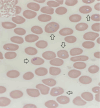Asplenia-Associated Babesiosis: A Quagmire Traversed by Exchange Transfusion
- PMID: 38993805
- PMCID: PMC11236333
- DOI: 10.14740/jmc4247
Asplenia-Associated Babesiosis: A Quagmire Traversed by Exchange Transfusion
Abstract
Babesiosis is a potentially life-threatening tick-borne parasitic infection. Severe disease in splenectomized individuals may require exchange transfusion. A 58-year-old male with a history of splenectomy presented with 2 weeks of subjective fever, weakness, and abdominal pain. He denied any rashes, tick bites, or recent travel. He had a motor vehicle accident a few years ago and had undergone an emergency splenectomy. On examination, the patient was febrile (39.3 °C), tachycardic (106/min), and jaundiced. Labs revealed anemia and thrombocytopenia. Computed tomography (CT) abdomen revealed asplenia. As it was summer, there was concern for a tick-borne illness. A peripheral smear showed schistocytes, and labs revealed hyperbilirubinemia, high lactate dehydrogenase (LDH), low haptoglobin, and reticulocytosis (13%), consistent with hemolysis. Testing for severe acute respiratory syndrome coronavirus 2 (SARS-CoV-2), Ehrlichia, Borrelia, Anaplasma, and viral hepatitis was negative. Antibody testing for Babesia microti was positive. A blood parasite smear confirmed Babesia microti with a parasitemia of 9.5%. The patient received intravenous azithromycin and atovaquone for severe babesiosis. On day 2 of hospitalization, parasitemia increased to 14.7%. Hemoglobin and platelets dropped further on day 3. His parasite load remained consistently above 10% despite medical treatment. A decision was made for a red blood cell (RBC) exchange transfusion for severe disease, which was performed on the fourth day of hospitalization. Clinical improvement was seen after one session of exchange RBC transfusion. Hemoglobin remained stable, and thrombocytopenia improved 1 day after RBC exchange transfusion. Parasitemia dropped to 1.2% after 4 days of exchange transfusion, and azithromycin was switched to oral. He received 9 days of inpatient azithromycin and atovaquone. He was discharged with a plan to continue the oral antimicrobials for 3 more weeks. Asplenia and parasitemia > 10% are associated with severe babesiosis. Asplenia, in particular, is associated with severe infection, hospitalization, and prolonged duration of therapy. Exchange transfusion in severe babesiosis can be lifesaving.
Keywords: Asplenia; Babesiosis; Exchange transfusion; Parasitemia.
Copyright 2024, Gondal et al.
Conflict of interest statement
The authors declare no conflict of interest.
Figures
References
Publication types
LinkOut - more resources
Full Text Sources
Research Materials
Miscellaneous

